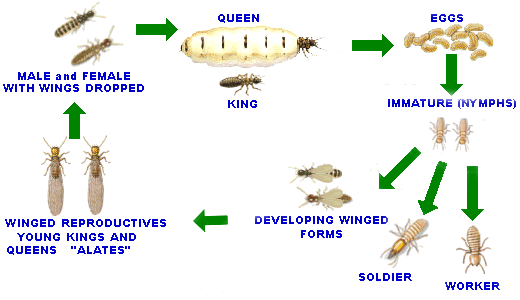Economic Significance: Formosan termites are the most aggressive
and destructive timber pests in the United States. It is an imported species,
native to China.
It can develop huge nests containing millions of termites aggressively
and relentlessly seeking and devouring structural timbers, utility poles
and other timber structures, including ships and barges. Infestation can
occur to living trees, such as oak, cypress, pine and maple.
They often cause power failures by chewing through electrical cabling.
A termite to be feared - it is known to cause major structural timber
damage to homes and buildings within a few months.
Area of Distribution: The Formosan subterranean termite (
Coptotermes
formosanus) has now become established in Mississippi and other southern
states. At least one colony has been found In California (1995).
Formosan termites are a serious timber pest in Hawaii and coastal regions
of Texas, Mississippi, Louisiana, Alabama, Florida, Tennessee, Georgia,
South Carolina and southern California, as well as, inland towns and cities.
The Formosan termite is rarely found North of 35° N latitude. They
have been reported from the following states: Alabama, California, Florida,
Georgia, Hawaii, Louisiana, Mississippi, North Carolina, South Carolina,
Tennessee, and Texas. Their distribution will probably continue to be
restricted to southern areas because their eggs will not hatch below about
20° C (68° F).
Identification of Swarmers and Soldiers: Formosan termites swarm in huge
numbers in late spring or summer; usually following a warm rainy day.
They prefer to swarm in times of high humidity in the evening hours from
dusk to midnight. The swarmers are attracted to lights and are about 1/25'',
including wings. Their body color is pale yellowish brown. A fontanelle
(frontal gland pore) is present.
The swarmers have four wings of equal size with dark hard veins in the
front portion of the front wing. The wings are a translucent, slightly
milky color and covered with tiny hairs. The armoured head of the soldier
is rounded tapering toward the front. A fontanelle (frontal gland pore)
is present on the soldier's forehead. They have large mandibles relative
to their body, which is flat and narrower than the head.
When disturbed the Formosan soldier termite may emit a white sticky latex
substance from it's fontanelle - a defensive measure to ensnare their
enemies, primarily ants.
Identification of Timber Damage: Formosan termites eat mainly the springwood
of susceptible timbers, most often leaving the summer wood sections. Timbers
infested by Formosan termites usually have layered sections packed with
moist soil in high activity areas.
Biology and Habits: Formosan termites are subterranean termites that typically
live in the ground and a large mature nest will periodically emit swarmers
in large numbers over a wide area to find a mate from another colony nest
to start up a new colony. A suitable location for nesting should provide
a constant moisture source and a readily available timber food source
close by.
Several years are required before the termite colony reaches the typically
mature size, which may contain millions of termites foraging for timber
food sources within a 400 feet radius, actively feeding on trees and free-standing
poles as well as buildings and other timber structures.
The colony nests of Formosan termites are usually located in the ground
below the frost line, but above the water table. They typically construct
mud galleries or "shelter tubes" across hard objects in order
to gain access to timber food sources.
Formosan termites constantly search for new food sources. They are known
to enter buildings through cracks in concrete flooring or to travel under
parquetry or tile flooring through gaps of less than 1/16" wide.
The space between the foundation and the first mortar joint is often enough
space for termites to enter a home.
Formosan termites can establish secondary colonies in very moist wood
of upper stories of buildings (even several stories above ground) and
do not need soil contact if there is a nearly constant moisture source.
Where moisture regularly collects inside the wall or other cavities of
a building, say from faulty plumbing or broken roof tiles, the Formosan
termite can develop a subsidiary colony nest, which may not require contact
with the ground to ensure its survival. This is particularly prevalent
in areas of high humidity where wood moisture is above average.
Due to its size and aggressive foraging behaviour a colony of Formosan
termites does more damage than single colonies of other U.S. subterranean
species, and can cause significant structural damage to a home within
6 months.










